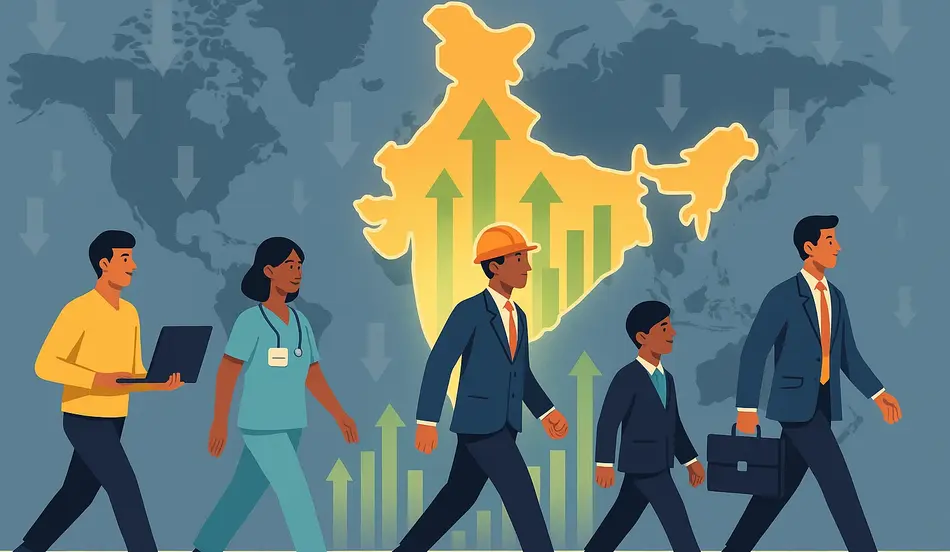In much of the world, the labor market is cooling. Employers in the United States, Europe, and East Asia are cutting back on hiring, citing inflation, tariffs, and automation pressures. Yet in India, the story could not be more different.
According to the latest surveys and recruitment data, 72% of Indian employers expect to add net new jobs in the second half of 2025. This optimism stands in stark contrast to the global picture, where hiring plans are subdued and job creation forecasts are being revised downward.
India’s momentum is not accidental. It is the result of a combination of factors: government policy incentives, a vast and youthful workforce, multinational investment, and an economy that is expanding despite global headwinds. At a time when the world worries about AI displacing jobs, India is doubling down on growth.
Employer Confidence Soars
A Naukri Hiring Outlook report for 2025 reveals striking numbers:
- 94% of employers plan to hire in some capacity during the next two quarters.
- 72% of employers are targeting net new job creation, not just replacement hiring.
- 87% say AI adoption will not reduce overall jobs, while 13% believe it could create more jobs through complementary demand.
These figures place India in a rare category of economies where hiring momentum is accelerating instead of slowing.
Global Context: A Tale of Two Worlds
The contrast with other major economies is stark:
- In the United States, one in five employers plans to slow hiring in the second half of 2025.
- The European Union is projected to lose millions of working-age adults over the next decade, while current job growth remains tepid.
- In Japan, ultra-low unemployment masks stagnant wage growth and underemployment challenges.
Against this backdrop, India’s projected job growth is attracting international attention. Multinationals see the country not just as a consumer market but as a critical workforce hub.
Government Incentives: The $11.7 Billion Push
The Indian government has doubled down on employment policy. In July 2025, it approved an Employment-Linked Incentive (ELI) scheme worth $11.7 billion, aiming to:
- Create 35 million new jobs by 2027.
- Offer direct subsidies to first-time jobholders to offset training costs.
- Provide incentives to companies that expand payrolls.
This policy, coupled with earlier skilling and digital infrastructure initiatives, is designed to formalize the labor market and bring millions of young workers into stable jobs.
Multinational Expansion Fuels Demand
Foreign direct investment is playing a decisive role in sustaining India’s hiring momentum:
- Global trading firms such as Citadel Securities, IMC, Millennium, and Optiver are aggressively expanding, recruiting from IITs and other top schools. IMC plans to increase headcount in India by 50%, while Optiver aims to add 100 employees by year-end.
- Professional services and consulting firms like Alvarez & Marsal plan to triple their India-based staff from 700 to 2,000 by 2028, cementing India as a global delivery center.
- Tech giants including Amazon, Microsoft, and Walmart continue to scale up their capability centers in Bengaluru, Hyderabad, and Pune, supporting global operations.
These expansions confirm India’s role as the world’s leading talent hub—especially as companies diversify away from China and look for reliable, English-speaking talent at scale.
Sectoral Hiring Trends
Technology & AI
India is both a beneficiary and a contributor to the global AI wave. Rather than displacing jobs, AI is generating new demand for AI-literate workers, particularly in data science, machine learning engineering, and analytics.
Healthcare & Pharmaceuticals
India’s large domestic demand for healthcare, combined with its global role as a pharmaceutical manufacturing hub, continues to fuel hiring. Nurse practitioners, biotech researchers, and healthcare administrators are in demand.
Manufacturing & Construction
The government’s “Make in India” initiative and infrastructure projects are driving strong demand for engineers, technicians, and construction workers.
Consumer Durables & Retail
Hiring in fast-moving consumer durables (FMCD) has grown 30% in two years, although women account for just 9% of the workforce—highlighting persistent gender imbalances.
Tap Into India’s Global Talent Hub
Join leading multinationals hiring top professionals in tech, finance, and consulting. Post your job and connect with India’s best talent today.
Post a Job Now →Youthful Workforce: India’s Secret Weapon
India’s demographics are unmatched. With a median age of just 28, it has one of the youngest workforces in the world. While Europe and Japan grapple with shrinking labor pools, India has an abundant supply of workers ready to fill new roles.
However, this “demographic dividend” only pays off if job creation keeps pace with population growth. So far, 2025’s momentum suggests progress, but sustaining it will require continued investment in skilling and infrastructure.
Challenges That Could Slow the Momentum
Despite the positive outlook, risks remain:
- Skills Gap: While India produces millions of graduates, many lack the specialized skills employers seek, particularly in AI and emerging technologies.
- Gender Disparity: Women’s labor participation remains low compared to global peers. Without greater inclusion, India risks underutilizing half its talent pool.
- Job Quality: Much of the job growth is concentrated in entry-level or mid-skill positions. Ensuring stable, formal jobs rather than temporary contracts will be critical.
- Global Economic Shocks: Tariffs, energy volatility, or geopolitical tensions could dampen multinational expansion into India.
Historical Parallels: Lessons from the Past
India’s current moment echoes past labor market booms:
- China’s manufacturing surge (1990s–2000s): Fueled by FDI and demographics, China became the world’s factory. India now aspires to replicate this success in services and tech.
- U.S. postwar baby boom (1950s–60s): A young workforce powered rapid growth, but it required massive investment in education and infrastructure—parallels India must heed.
The lesson is clear: demographics alone are not enough. Strategic policy and sustained private investment must underpin long-term labor market success.
Implications for the Global Labor Market
India’s hiring surge carries implications beyond its borders:
- Talent Competition: As multinationals expand in India, they may reduce hiring in Western economies, contributing to the hiring slowdown abroad.
- AI Workforce Dynamics: India could emerge as the world’s largest supplier of AI-trained talent, shaping how the technology is adopted globally.
- Policy Pressure: Other developing nations may emulate India’s Employment-Linked Incentive scheme, sparking a new wave of job-focused industrial policy.
FAQs
Q1: Why is India’s hiring outlook stronger than other countries?
Because of government incentives, a young workforce, multinational expansion, and strong domestic demand across sectors.
Q2: Is AI a threat to Indian jobs?
So far, employers see AI as a catalyst, not a destroyer. Demand for AI-skilled roles is outpacing automation losses.
Q3: Whichsectors are hiring the most?
Technology, manufacturing, healthcare, construction, and consumer durables are leading the surge.
Q4: What risks could derail this hiring boom?
Skills shortages, gender disparities, contract-heavy job creation, and global shocks like tariffs or energy crises.
Conclusion
India’s hiring surge is one of the most striking economic stories of 2025. While rich economies wrestle with demographic decline, cautious employers, and AI-driven disruption, India is charting a different path—one of expansion, optimism, and strategic investment in its workforce.
The road ahead is not without obstacles, from skills mismatches to gender gaps. Yet India’s momentum signals a powerful truth: in a world of fragile labor markets, the future of employment may be shaped not in Washington, London, or Tokyo—but in Bengaluru, Hyderabad, and Mumbai.




